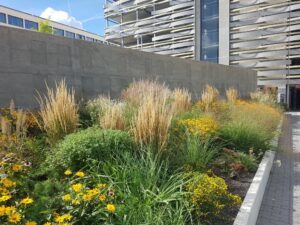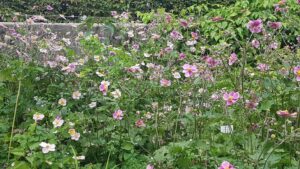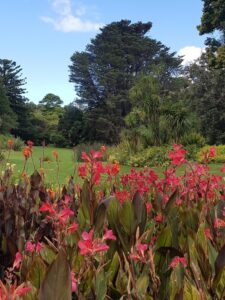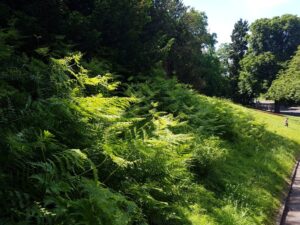
Think big with mass plantings
By John Fitzsimmons
When we are in landscape mode we often think of architectural plants, specimen trees, colour palettes, textures, borders and backdrops for impact and low maintenance. We should not however forget the visual impact and benefits of one of the most widely used landscape elements and approaches — mass plantings.
Mass planting is widely used in landscaping, however, it has been also described as ‘often overlooked or underdone’. Where the outcome does not match expectations, the causes can range from lack of planning through poor plant selection to poor implementation and even simple under-budgeting (including under-quoting) or even a lack of fortitude to back the vision in all the way. So let us review some aspects of mass plantings in our landscapes.
Firstly, definitions and it is pretty much what it ‘says on the pack’; planting one plant species, or similar looking plants, together in extensive groups. Multiple complementary mass plantings utilising waves, bands, drifts, zones and stages of same-species optional sizes, colours and textures (e.g. Acacia cognata or Anigozanthos spp. selections) can be highly impactful and engaging.

In another direction, mass plantings of succulents of various colours and forms, underplanted with bulbs (think tulips, daffodils, jonquils) result in dramatic seasonal changes and contrasts as each plant group comes into flower, emerging, dominating and receding.
Height-structured designs utilising groundcovers, grasses, shrubs and trees can combine the impact of mass planting with the engagement of three-dimensional complex combinations.
So, the effect can be created by colour, form, scale, complexity, and through time dimensions via seasonal changes. The options can be better visualised by knowing more about your plant options, i.e. their growth habits, and seasonal changes in colour and form. Landscapers can focus on different plant groups and themes to develop their own aesthetic, even their own ‘brand’. Certain landscape designers have become recognisable, famous and highly successful this way.
The ultimate quality and longevity of a mass planting will be a result of the lifespan of perennial species and/or the persistence of annuals, the quantity of viable seed set and germination conditions, combined with the maintenance of the planting in terms of longer-term nutrition, rainfall/irrigation, pest and disease control (or resistance), and pruning or trimming where desirable.

Plants grown en masse have many benefits although visual appeal and showcasing of various plants or elements are well to the fore. Wildlife habitat and pollinator attraction (e.g. bees) are also offered as benefits depending on species and situation. Do not forget the importance of ‘wildlife’ underground either.
Similar plants sited together can often have similar growing needs. This can make maintaining and sustaining the planting easier as they share similar water and nutrient requirements, and similar light and soil structure preferences.
Depending on the site, mass plantings can bring beauty to otherwise unappealing or unsightly places.
They can, in certain circumstances, also perform a practical role in soil erosion control or terrain stabilisation. It has been stated that effective erosion control is rarely achieved with a single species. Instead, plant communities with complementary root systems, growth forms and canopy layers will create a more stable, resilient and self-reinforcing system. Different plant groups perform different complementary roles in topsoil stabilisation, subsoil stability, absorbing the energy of rainfall (or overhead irrigation) droplets and slowing (or preventing) runoff.
Especially with mass plantings of grasses, care should be taken to avoid invasive selections and consider the preferred nature of root systems (clumping or running).
A well established and maintained mass planting can also be highly effective as a weed suppressant, denying undesirable plants light, nutrients, and establishment or growing conditions.

Certain species employed in mass plantings are also associated with fire protection zones, combining a practical benefit with an improved aesthetic, e.g. Carpobrotus glaucescens, Aloe Sea Urchin™.
The setting and site objectives can be central to mass planting designs and choices. Is the design intended to complement a period or distinctive residence? Soften commercial or industrial architecture? Or needed to ‘zone’ or protect a public amenity site?
Plant density (the number of plants per unit of area) is critical to the ultimate success of mass plantings. Competition for light, nutrients and water means that the availability of those life essentials will (depending on species) be correlated with ultimate plant density. Plant density will also have effects on individual plant structure and development patterns.
The relationships between plant density and plant growth have been studied widely, especially in food crops and forestry. The broad relationships in a ‘monostand’* between plant density, total above ground biomass, individual plant biomass and Leaf Area Index have been observed for many plant groups; the ultimate relationships are related to species (genetics/genotype) and how different individual plants respond to their growing environment (phenotype). It is a very interesting area for further personal and general study.
In the meantime, our plant breeders and propagators have accumulated much knowledge to aid horticulturists and landscape designers visualise and create highly successful, engaging and impactful mass plantings. It is readily available and willingly shared in the interests of mutual success. So, there are no excuses for not getting out there, thinking big and going large with mass plantings.
*Monostand: an area of same-species plants sown or planted at the same time.
(All images: John Fitzsimmons – KonzeptVZ)
